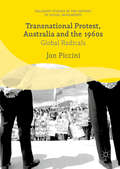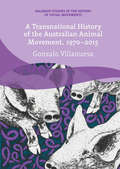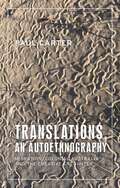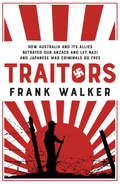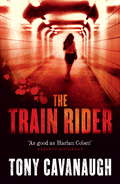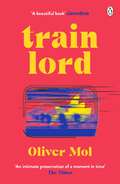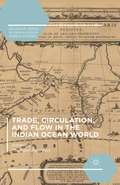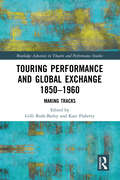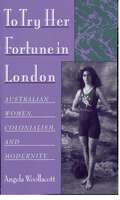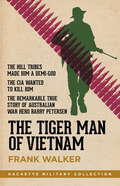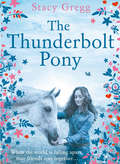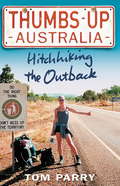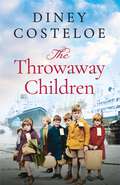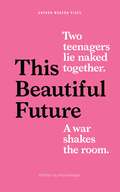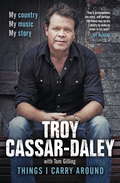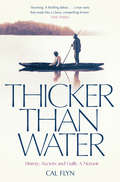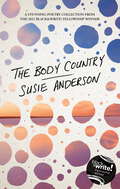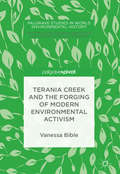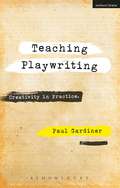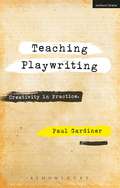- Table View
- List View
Transnational Protest, Australia and the 1960s (Palgrave Studies in the History of Social Movements)
by Jon PicciniAustralia is rarely considered to have been a part of the great political changes that swept the world in the 1960s: the struggles of the American civil rights movement, student revolts in Europe, guerrilla struggles across the Third World and demands for women’s and gay liberation. This book tells the story of how Australian activists from a diversity of movements read about, borrowed from, physically encountered and critiqued overseas manifestations of these rebellions, as well as locating the impact of radical visitors to the nation. It situates Australian protest and reform movements within a properly global – and particularly Asian – context, where Australian protestors sought answers, utopias and allies. Dramatically broadens our understanding of Australian protest movements, this book presents them not only as manifestations of local issues and causes but as fundamentally tied to ideas, developments and personalities overseas, particularly to socialist states and struggles in near neighbours like Vietnam, Malaysia and China.'Jon Piccini is Research and Teaching Fellow at The University of Queensland, Brisbane, Australia. His research interests include the history of human rights and social histories of international student migration.'
A Transnational History of the Australian Animal Movement, 1970-2015
by Gonzalo VillanuevaThis book offers the first transnational historical study of the creation, contention and consequences of the Australian animal movement. Largely inspired by Peter Singer and his 1975 book Animal Liberation, a new wave of animal activism emerged in Australia and across the world. In an effort to draw public and media attention to the plight of animals, such as the rearing of pigs and poultry in factory farms and the export of live animals to the Middle East and South East Asia, Australian activists were often innovative and provocative in how they made their claims. Through lobbying, disruptive methods, and vegan activism, the animal movement consistently contested the politics and culture of how animals were used and exploited. Australians not only observed and learnt from people and events overseas, but also played significant international roles. This book examines the complex and conflicting consequences of the animal movement for Australian politics, as well as its influence on broader social change.
A Transnational History of the Australian Animal Movement, 1970-2015
by Gonzalo VillanuevaThis book offers the first transnational historical study of the creation, contention and consequences of the Australian animal movement. Largely inspired by Peter Singer and his 1975 book Animal Liberation, a new wave of animal activism emerged in Australia and across the world. In an effort to draw public and media attention to the plight of animals, such as the rearing of pigs and poultry in factory farms and the export of live animals to the Middle East and South East Asia, Australian activists were often innovative and provocative in how they made their claims. Through lobbying, disruptive methods, and vegan activism, the animal movement consistently contested the politics and culture of how animals were used and exploited. Australians not only observed and learnt from people and events overseas, but also played significant international roles. This book examines the complex and conflicting consequences of the animal movement for Australian politics, as well as its influence on broader social change.
Translations, an autoethnography: Migration, colonial Australia and the creative encounter (Anthropology, Creative Practice and Ethnography)
by Paul CarterTranslations is a personal history written at the intersection of colonial anthropology, creative practice and migrant ethnography. Renowned postcolonial scholar, public artist and radio maker, UK-born Paul Carter documents and discusses a prodigiously varied and original trajectory of writing, sound installation and public space dramaturgy produced in Australia to present the phenomenon of contemporary migration in an entirely new light. Migrant space-time, Carter argues, is not linear, but turbulent, vortical and opportunistic. Before-and-after narratives fail to capture the work of self-becoming and serve merely to perpetuate colonialist fantasies. The ‘mirror state’ relationship between England and Australia, its structurally symmetrical histories of land theft and internal colonisation, repress the appearance of new subjects and subject relations. Reflecting on collaborations with Aboriginal artists, Carter argues for a new definition of the stranger-host relationship predicated on recognition of Aboriginal sovereignty. Carter calls the creative practice that breaks the cycle of repeated invasion ‘dirty art’. Translations is a passionately eloquent argument for reframing borders as crossing-places: framing less murderous exchange rates, symbolic literacy, creative courage and, above all, the emergence of a resilient migrant poetics will be essential.
Translations, an autoethnography: Migration, colonial Australia and the creative encounter (Anthropology, Creative Practice and Ethnography)
by Paul CarterTranslations is a personal history written at the intersection of colonial anthropology, creative practice and migrant ethnography. Renowned postcolonial scholar, public artist and radio maker, UK-born Paul Carter documents and discusses a prodigiously varied and original trajectory of writing, sound installation and public space dramaturgy produced in Australia to present the phenomenon of contemporary migration in an entirely new light. Migrant space-time, Carter argues, is not linear, but turbulent, vortical and opportunistic. Before-and-after narratives fail to capture the work of self-becoming and serve merely to perpetuate colonialist fantasies. The ‘mirror state’ relationship between England and Australia, its structurally symmetrical histories of land theft and internal colonisation, repress the appearance of new subjects and subject relations. Reflecting on collaborations with Aboriginal artists, Carter argues for a new definition of the stranger-host relationship predicated on recognition of Aboriginal sovereignty. Carter calls the creative practice that breaks the cycle of repeated invasion ‘dirty art’. Translations is a passionately eloquent argument for reframing borders as crossing-places: framing less murderous exchange rates, symbolic literacy, creative courage and, above all, the emergence of a resilient migrant poetics will be essential.
Traitors: How Australia and its Allies betrayed our ANZACs and let Nazi and Japanese war criminals go free
by Frank WalkerIn October 1943 Winston Churchill, Franklin D. Roosevelt and Josef Stalin signed a solemn pact that once their enemies were defeated the Allied powers would 'pursue them to the uttermost ends of the earth and will deliver them to their accusers in order that justice may be done'. Nowhere did they say that justice would be selective. But it would prove to be.TRAITORS outlines the treachery of the British, American and Australian governments, who turned a blind eye to those who experimented on Australian prisoners of war. Journalist and bestselling author Frank Walker details how Nazis hired by ASIO were encouraged to settle in Australia and how the Catholic Church, CIA and MI6 helped the worst Nazi war criminals escape justice. While our soldiers were asked to risk their lives for King and country, Allied corporations traded with the enemy; Nazi and Japanese scientists were enticed to work for Australia, the US and UK; and Australia's own Hollywood hero Errol Flynn was associating with Nazi spies. The extraordinary revelations in TRAITORS detail the ugly side of war and power and the many betrayals of our ANZACs. After reading this book you can't help but wonder, what else did they hide?
The Train Rider (The Darian Richards Series #3)
by Tony Cavanaugh'Tony Cavanaugh brings new depth and dimension to crime fiction in this country' - The Weekend WestOne man pushed Darian Richards to the edge. The man he couldn't catch. The Train Rider.As Victoria's top homicide investigator, Darian Richards spent years catching killers. The crimes of passion, of anger, of revenge ... they were easy. It was the monsters who were hard.Someone was taking girls. At first he'd keep them a week then give them back. Darian warned that wouldn't last. It didn't. From then on, their bodies were never found. Girls kept disappearing. All they had in common was the fact they'd last been seen on a train.The ever-rising list of the vanished broke Darian. Forced him to walk away. Now, retired, watching the Noosa River flow by, the nightmares had finally stopped. Darian was never going back.Then three girls go missing from Queensland trains. Darian knows that the killer is playing him. He has a choice to make. But when the decision means a girl will die, there is no choice. He has to stop this man once and for all. Forever.Tony Cavanaugh is an Australian writer and producer of film and television. The Train Rider is his latest book featuring cop Darian Richards and follows on from the acclaimed crime thrillers Promise and Dead Girl Sing.The Darian Richards SeriesPromiseDead Girl Sing The Soft Touch (Short Story) The Train Rider Kingdom of the Strong
Train Lord: The Astonishing True Story of One Man's Journey to Getting His Life Back On Track
by Oliver MolThe astonishing true story of trust, pain, becoming lost, and finding a way back to yourself despite it allWhat happens when a writer can no longer write? What happens when pain is so intense that you question who you are and whether you can bear it any longer?Oliver Mol was a successful, clever, healthy twenty-five-year old. Then one day the migraine started.For ten months, the pain was constant, exacerbated by writing, reading, using computers, looking at phones or anything with a screen. Slowly he became a writer who could no longer write, and a person who could no longer communicate with the modern world. In literature, and life, Oliver began to disappear.His doctors couldn't figure out how to fix him. He suffered a breakdown. And one evening, high on painkillers, Oliver Googled the only thing he could think of: 'full-time job, no experience, Sydney'. An ad for a train guard appeared and, desperate, Oliver took it.For two years Oliver watched others live their lives, observing the minutia and intimacy of strangers brought together briefly and connected by the steady march of time. Exquisitely written and bravely told, Train Lord is a searingly personal yet universal book, which asks what happens when your sense of self is suddenly destroyed, and how you get it back.
Trade, Circulation, and Flow in the Indian Ocean World (Palgrave Series in Indian Ocean World Studies)
by Michael PearsonTrade, Circulation, and Flow in the Indian Ocean World is a collection which covers a long time span and diverse areas around the ocean. Many of the essays look at the Indian Ocean before Europeans arrived, reminding the reader that there was a cohesive Indian Ocean. This collection includes empirical studies and essays focused on particular area or production. The essays cover various aspects of trade and exchange, the Indian Ocean as a world-system, East African and Chinese connections with the Indian Ocean World, and the movement of people and ideas around the ocean.
Touring Performance and Global Exchange 1850-1960: Making Tracks (Routledge Advances in Theatre & Performance Studies)
by Gilli Bush-BaileyThis collection uncovers connections and coincidences that challenge the old stories of pioneering performers who crossed the Atlantic and Pacific oceans from the mid-nineteenth to the mid-twentieth century. This book investigates songlines, drama, opera, music theatre, dance, and circus—removing traditional boundaries that separate studies of performance, and celebrating difference and transformation in style, intention, and delivery. Well known, or not known at all, travelling performers faced dangers at sea and hazardous journeys across land. Their tracks, made in pursuit of fortune and fame, intersected with those made by earlier storytellers in search for food. Making Tracks takes a fresh look at such tracks—the material remains—demonstrating that moving performance does far more than transfer repertoires and people; it transforms them. Touring performance has too often been conceived in diasporic terms, as a fixed product radiating out from a cultural centre. This collection maps different patterns—ones that comprise reversed flows, cross currents, and continually proliferating centres of meaning in complex networks of global exchange. This collection will be of great interest to scholars and students in theatre, music, drama studies and cultural history.
Touring Performance and Global Exchange 1850-1960: Making Tracks (Routledge Advances in Theatre & Performance Studies)
by Kate Flaherty Gilli Bush-BaileyThis collection uncovers connections and coincidences that challenge the old stories of pioneering performers who crossed the Atlantic and Pacific oceans from the mid-nineteenth to the mid-twentieth century. This book investigates songlines, drama, opera, music theatre, dance, and circus—removing traditional boundaries that separate studies of performance, and celebrating difference and transformation in style, intention, and delivery. Well known, or not known at all, travelling performers faced dangers at sea and hazardous journeys across land. Their tracks, made in pursuit of fortune and fame, intersected with those made by earlier storytellers in search for food. Making Tracks takes a fresh look at such tracks—the material remains—demonstrating that moving performance does far more than transfer repertoires and people; it transforms them. Touring performance has too often been conceived in diasporic terms, as a fixed product radiating out from a cultural centre. This collection maps different patterns—ones that comprise reversed flows, cross currents, and continually proliferating centres of meaning in complex networks of global exchange. This collection will be of great interest to scholars and students in theatre, music, drama studies and cultural history.
To Try Her Fortune in London: Australian Women, Colonialism, and Modernity
by Angela WoollacottBetween 1870 and 1940, tens of thousands of Australian women were drawn to London, their imperial metropolis and the center of the publishing, art, musical, theatrical, and educational worlds. Even more Australian women than men made the pilgrimage "home," seeking opportunities beyond those available to them in the Australian colonies or dominion. In tracing the experiences of these women, this volume reveals hitherto unexamined connections between whiteness, colonial status, gender, and modernity.
The Tiger Man of Vietnam (Hachette Military Collection)
by Frank WalkerThe Vietnamese hilltribes made him a demi-god. The CIA wanted to kill him. This is the remarkable true story of Australian war hero Barry Petersen.As he flew over South East Asia towards Vietnam, Captain Barry Petersen struggled to keep an aura of calm. Inwardly he was incredibly excited. Aged 28, highly trained, with experience in anti-communist guerilla warfare, he was about to embark on the biggest and most important mission of his life.In 1963, Australian Army Captain Barry Petersen was sent to Vietnam. It was one of the most tightly held secrets of the Vietnam War: long before combat troops set foot there and under the command of the CIA, Petersen was ordered to train and lead guerilla squads of Montagnard tribesmen against the Viet Cong in the remote Central Highlands.Petersen successfully formed a fearsome militia, named 'Tiger Men'. A canny leader, he was courageous in battle, and his bravery saw him awarded the coveted Military Cross, and worshipped by the hill tribes.But his success created enemies, not just within the Viet Cong. Like Marlon Brando's character in 'Apocolyse Now', some in the CIA saw Petersen as having gone native. His refusal, when asked, to turn his Tiger Men into assassins as part of the notorious CIA Phoenix Program only strengthened that belief. The CIA strongly resented anyone who stood in their way. Some in the US intelligence were determined Petersen had to go and he was lucky to make it out of the mountains alive. The Tiger Man of Vietnam reveals the compelling true story of little-known Australian war hero Barry Petersen.'One of those great untold stories and Walker tells it with verve and excitement and, with meticulous attention to detail' - Sydney Morning Herald'Drips with adventure and intrigue and has at its centre a personality boys of all ages will identify with' - The Age'Walker's finely researched book goes beyond the biographical account of an Australian war hero' - Sun Herald'Walker's book about Petersen, The Tiger Man Of Vietnam, is well-crafted and racily written' - Weekend Australian
The Thunderbolt Pony
by Stacy GreggA dramatic and emotional story about one girl’s determination to stand by her beloved animals – and her refusal to give up, even in the face of impossible odds.
Thumbs Up Australia: Hitchhiking the Outback
by Tom ParryOn the Road meets Down Under in this really rough guide to the adventures of an enthusiastic hitchhiker and his reluctant girlfriend on their quest for the real Australia. Hitching lifts with the desert's dodgiest drivers and taking breaks in the roughest roadhouses, this is Tom Parry's witty, warts-and-all tale of hitchhiking 8,000 miles across - and around - the Australian outback with his thumb, his backpack and his French girlfriend, Katia. As the couple hitch their way around the near empty highways, they encounter as wide a cross-section of Aussie society as you could ever hope to meet. In cattle stations, Aboriginal communities, remote waterholes, caravan parks, hippy communes and roadhouses, they see a country that remains as extraordinary today as it was for the first nineteenth century settlers. Loosely following the routes carved out by the legendary explorers who first traversed the great continent, the couple get to grips with the country's fascinating history. Set against a backdrop of the real Australia - not 'as seen on TV'- "Thumbs Up Australia" is full of wonderful anecdotes and endearing tales of some of the country's most idiosyncratic characters, from the grizzled Aboriginal elder with his tales of dreamtime, to an amphetamine-swallowing road train driver. And at the end of their journey, it is ironically Katia who suggests thumbing a lift to the airport!
The Throwaway Children
by Diney CosteloeGritty, heartrending and unputdownable – the story of two sisters sent first to an English, then an Australian orphanage in the aftermath of World War II. Rita and Rosie Stevens are only nine and five years old when their widowed mother marries a violent bully called Jimmy Randall and has a baby boy by him. Under pressure from her new husband, she is persuaded to send the girls to an orphanage – not knowing that the papers she has signed will entitle them to do what they like with the children. And it is not long before the powers that be decide to send a consignment of orphans to their sister institution in Australia. Among them – without their family's consent or knowledge – are Rita and Rosie, the throwaway children. What readers are saying about THE THROWAWAY CHILDREN: 'I haven't felt so immersed in a book in a very long time and have recommended to just about everyone' 'Heart wrenching' 'A truly powerful book'
This Beautiful Future (Oberon Modern Plays)
by Rita KalnejaisElodie is 17. She’s French. She lets down her hair and puts it up again. She finds reflective surfaces everywhere. She tests new looks. Otto is 15. He’s a German soldier. He brushes his hair to make the shape of his head more perfectly oval. He tries not to look at himself in the mirror. It’s 1944. Elodie and Otto are experiencing love for the very first time. Outside, the world around them is exploding. Inside, the room shakes. Elodie and Otto’s bodies touch. Fusing youth with old age, the past with the present, pop tunes with Stalingrad, This Beautiful Future is about love in the extreme.
Things I Carry Around: The bestselling memoir from the ARIA Award-winning country music star
by Tom Gilling Troy Cassar-DaleyA born storyteller, Troy Cassar-Daley has at last turned his talent to sharing his own inspiring life.‘Troy’s achievements are many, and perhaps the finest may be his ability to make us listen to his heart.’ Joy McKeanFor the first time, Troy talks about his early life - how his parent’s divorce changed things for him, about missing his Dad and growing up in Grafton surrounded by the warmth and love of his mother, Irene, his Nan and Pop and his extended Indigenous family. A larrikin at heart, Troy includes all the highs and lows on his path to stardom: the thrill of performing on stage at the Tamworth Music Festival with Jimmy Little when he was just 15; the excitement of heading off on tour with Brian Young and then discovering just how lonely life on the road could be; his first record deal; playing with the greats – Johnny Cash, Willie Nelson, Merle Haggard and Slim Dusty; his first album Beyond the Dancing, which blended his indigenous heritage with his rural background; meeting the woman who would steal his heart; recording in Nashville; and, finally, releasing True Believer, the album that really launched his career. The multiple Golden Guitar, APRA, ARIA and Deadlys winner also lets us in on some of the life lessons he learned the hard way, lessons that kept this prodigiously talented Aussie on the straight and narrow (most of the time). Things I Carry Around, is the warm, genuine, and inspiring story of a young indigenous Australian who had a dream and turned that dream into reality. ‘Troy’s a true gentleman, warm and genuine, always a pleasure to be around. He sings straight from his heart and straight from the heart of his country.’ Paul Kelly
Thicker Than Water: History, Secrets And Guilt: A Memoir
by Cal FlynCal Flyn was very proud when she discovered that her ancestor, Angus McMillan, had been a pioneer of colonial Australia. However, when she dug deeper, she began to question her pride. McMillan had not only cut tracks through the bush, but played a dark role in Australia's bloody history.
Theatre and Australia (Theatre And)
by Julian MeyrickHow has Australia developed, culturally? What is the relationship between European theatre and Aboriginal performance? How do the concepts of memory, space, and love intersect and inform all Australian drama?Theatre and Australia is a stark look at the signal contradictions that make up the nation's sense of self. Exploring how race, gender, and community have influenced Australia's cultural development, this book reveals the history of Australian theatre as a tussle with questions of identity that can neither be entirely repudiated nor fully resolved.This concise study traverses the narrative of Australian theatre since white settlement, examining some of the main plays and performances of the last 230 years, and illuminating the relationship between European, non-Indigenous, and First Nations drama.
Theatre and Australia (Theatre And)
by Julian MeyrickHow has Australia developed, culturally? What is the relationship between European theatre and Aboriginal performance? How do the concepts of memory, space, and love intersect and inform all Australian drama?Theatre and Australia is a stark look at the signal contradictions that make up the nation's sense of self. Exploring how race, gender, and community have influenced Australia's cultural development, this book reveals the history of Australian theatre as a tussle with questions of identity that can neither be entirely repudiated nor fully resolved.This concise study traverses the narrative of Australian theatre since white settlement, examining some of the main plays and performances of the last 230 years, and illuminating the relationship between European, non-Indigenous, and First Nations drama.
the body country
by Susie Anderson'I keep looking at the stars to see the universe, but the joke is I am the universe.' the body country is an evocative exploration of a world that too often marginalises and the power of a land that can offer connection. A meditation of wandering and wondering on Country, inviting the reader to understand the complexities and changing forms of self and love.A Wergaia and Wemba Wemba woman, Susie Anderson captures profound meaning in moments often lost in the busyness of a day, encouraging us all to stop and allow ourselves the space to notice. To notice the shape of a mouth as it says goodbye; the colour of the sky as you fall in love; the way a steering wheel is turned carelessly after many wines; the crunch of dry ground after drought; the smell of fire on the wind; the movement of ants before rain; the power a word, a dress, a piece of art can give to run towards something new. These are poems that take us across rural and urban settings; from the personal to the universal, from looking inward to mapping the land and always bringing us back to the Country that connects us all.'Anderson pays attention to the moments that slip through the cracks and hands them straight to you in a way that can momentarily stun' Harper's Bazaar'The Body Country is an evocative exploration of a world that too often marginalises and the power of a land that can offer connection. Susie captures profound meaning in moments often lost in the busyness of a day, encouraging us all to stop and allow ourselves the space to notice' Wimmera Mail Times
Terania Creek and the Forging of Modern Environmental Activism (Palgrave Studies in World Environmental History)
by Vanessa BibleThis book tells the story of Terania Creek – the world’s first direct action blockade in defence of a forest, occurring in Australia in 1979. Contrary to claims that the Australian counterculture was a mere imitation of overseas models, the Australian movement, coalescing with a home-grown environment movement, came of age at Terania Creek. After five years of ‘polite’ campaigning failed to stop the logging of ancient Gondwanan rainforest, an organic and spontaneous blockade erupted that would see the forging of a number of ingenious blockading techniques and strategies. The activist repertoire developed at Terania Creek has since echoed across the country, and across the Earth. This book draws on extensive oral history interviews as well as photographs taken of the protest in 1979; such rich source material brings the story to life. Terania Creek and the Forging of Modern Environmental Activism will therefore appeal to both a scholarly audience as well as activists, practitioners, and counterculturalists.
Teaching Playwriting: Creativity in Practice
by Paul GardinerPlaywriting is a skill under-explored in the classroom, despite the strong evidence that it's an engaging and rewarding activity for young people. Teaching Playwriting addresses this gap and is an essential resource for teachers wanting to gain the skills and confidence necessary to introduce playwriting to their students. Based on rich research and clearly explained theoretical concepts, the book explores the lessons from creativity theory that will provide the teacher with the skills and knowledge necessary to empower students' writing and creativity. It also includes extensive practical activities and writing exercises to develop students' playwriting proficiency and creative capacity.Discussing key concepts in playwriting such as idea, dialogue, character, action and structure, the book enables teachers to respond to the unique learning needs of their students and help them tell their stories and reach their potential as young playwrights.
Teaching Playwriting: Creativity in Practice
by Paul GardinerPlaywriting is a skill under-explored in the classroom, despite the strong evidence that it's an engaging and rewarding activity for young people. Teaching Playwriting addresses this gap and is an essential resource for teachers wanting to gain the skills and confidence necessary to introduce playwriting to their students. Based on rich research and clearly explained theoretical concepts, the book explores the lessons from creativity theory that will provide the teacher with the skills and knowledge necessary to empower students' writing and creativity. It also includes extensive practical activities and writing exercises to develop students' playwriting proficiency and creative capacity.Discussing key concepts in playwriting such as idea, dialogue, character, action and structure, the book enables teachers to respond to the unique learning needs of their students and help them tell their stories and reach their potential as young playwrights.
